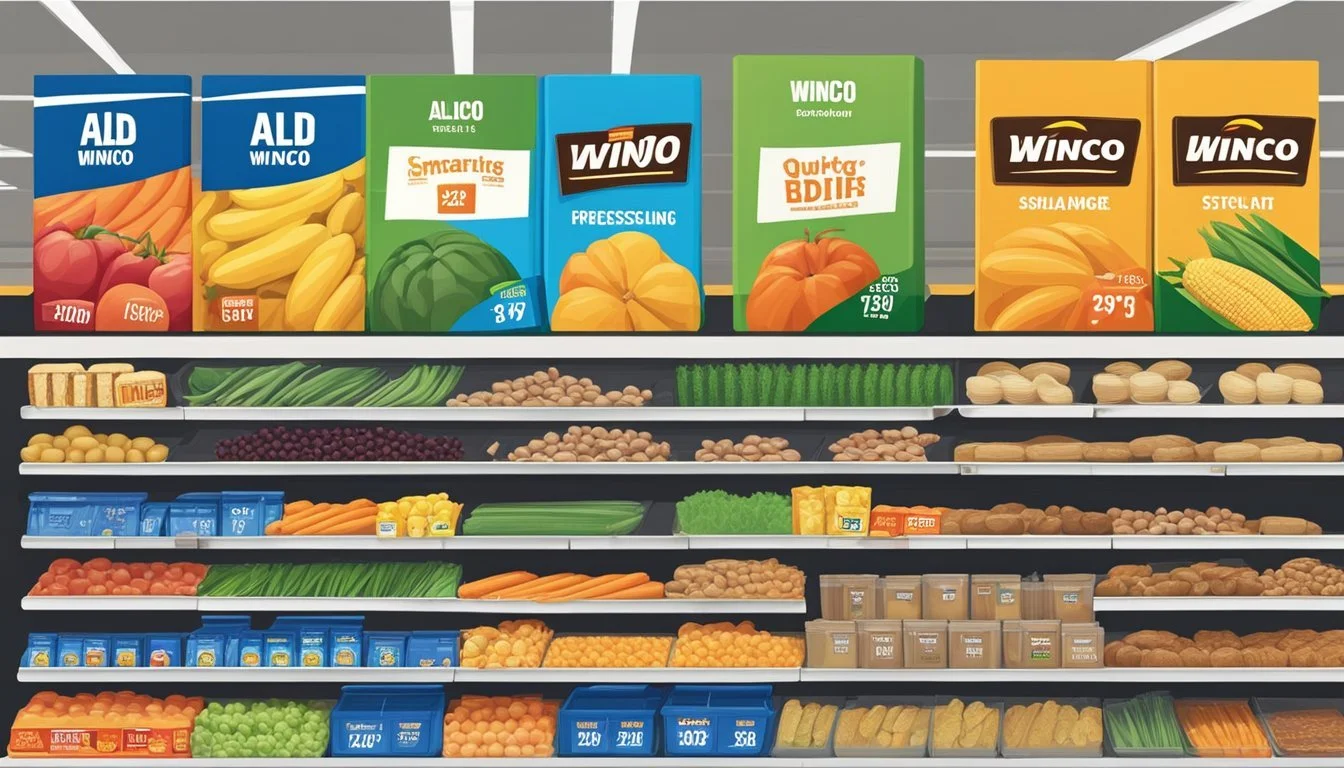Is Aldi Cheaper Than WinCo Foods?
A price comparison of budget grocery chains
Grocery shopping on a budget requires careful consideration of various stores and their pricing strategies. Aldi and WinCo Foods are two popular options known for their competitive prices and no-frills approach to retail.
Generally, WinCo Foods tends to be slightly cheaper than Aldi, offering lower prices on many items. Both stores employ cost-cutting measures to keep prices down, such as limiting product selection and using private label brands. WinCo's bulk food section and employee-owned business model contribute to its ability to offer rock-bottom prices.
While Aldi may not always have the absolute lowest prices, it still provides significant savings compared to traditional supermarkets. The difference in pricing between Aldi and WinCo can vary depending on location and specific products. Shoppers looking to maximize their savings might benefit from comparing prices at both stores for their most frequently purchased items.
Comparing Grocery Store Prices
Aldi and WinCo Foods both offer competitive pricing on groceries. A detailed analysis of common items and promotional strategies reveals key differences in their pricing approaches.
Price Analysis of Common Groceries
Aldi typically offers lower prices on everyday staples. Their store-brand items are often 20-30% cheaper than national brands at other stores. WinCo Foods excels in bulk pricing, with significant savings on larger quantities.
A price comparison of key items:
Milk: Aldi $2.79/gallon, WinCo $2.89/gallon
Eggs: Aldi $1.99/dozen, WinCo $2.15/dozen
Bread: Aldi $0.89/loaf, WinCo $1.08/loaf
WinCo's prices on produce and meat are generally lower than Aldi's. Fresh fruits and vegetables at WinCo can be 10-15% cheaper. Ground beef is often $0.50-$0.75 less per pound at WinCo compared to Aldi.
Impact of Discounts and Coupons
Aldi rarely offers coupons or loyalty programs. Their strategy focuses on consistently low prices. WinCo Foods provides more traditional discount options.
WinCo accepts manufacturer coupons, potentially leading to deeper savings. They also feature weekly sales on select items, with discounts ranging from 10-30% off regular prices.
Aldi's Special Buys program offers limited-time deals on non-grocery items. These can provide significant savings, but availability is limited.
WinCo's bulk section allows shoppers to buy only the amount needed, reducing waste and saving money on pantry staples and snacks.
Understanding Store Brands and Quality
Store brands and quality perceptions play a significant role in price comparisons between budget retailers like Aldi and WinCo Foods. These factors influence consumer choices and overall shopping experiences.
Store Brands vs. National Brands
Both Aldi and WinCo Foods offer extensive store brand options. Aldi's exclusive brands make up about 90% of their product selection. WinCo Foods also carries a wide range of store-brand items alongside national brands.
Store brands typically cost 15-30% less than comparable national brands. This pricing strategy allows budget retailers to offer lower prices while maintaining profit margins.
Quality can vary between store and national brands. Many store-brand products are manufactured by the same companies that produce national brands, often using similar ingredients and processes.
Blind taste tests have shown that consumers often can't distinguish between store and national brands for many products. This suggests comparable quality in many cases.
Perception of Quality in Budget Retailers
Budget retailers like Aldi and WinCo Foods have worked to improve quality perceptions. Aldi has introduced organic and premium product lines to appeal to quality-conscious shoppers.
WinCo Foods emphasizes fresh produce and bulk foods, which can enhance quality perceptions. Their large produce sections often feature locally sourced items when available.
Store layout and presentation influence quality perceptions. Aldi's minimalist approach may lead some shoppers to perceive lower quality. WinCo's larger stores and wider selection might create a more positive quality impression for some customers.
Product turnover rates in budget stores are often high due to lower prices. This can result in fresher products, particularly for perishable items like produce and dairy.
Customer reviews and word-of-mouth play a crucial role in shaping quality perceptions for budget retailers. Both Aldi and WinCo Foods have loyal customer bases who vouch for product quality.
Shopping Experience Comparison
Aldi and WinCo Foods offer distinct shopping experiences that cater to different customer preferences. Both stores prioritize affordability but differ in their approach to store design and customer service.
Store Layout and Design
Aldi stores are typically smaller and more compact than WinCo Foods. Aldi's layout focuses on efficiency, with a limited selection of products displayed in their original shipping boxes. This approach reduces overhead costs and keeps prices low.
WinCo Foods, on the other hand, features larger stores with a wider variety of products. The supermarket offers a more traditional shopping experience, with aisles organized by product categories. WinCo's bulk food section is a standout feature, allowing customers to purchase exactly the amount they need.
Both stores require customers to bring their own shopping bags or purchase them at checkout. Aldi's shopping carts require a quarter deposit, which is refunded upon return, promoting efficiency and reducing cart retrieval costs.
Customer Service
Aldi's customer service model is streamlined to maintain low prices. Cashiers are trained to be quick and efficient, often managing multiple tasks. The store's no-frills approach means fewer staff members are available for assistance on the floor.
WinCo Foods provides a more conventional customer service experience. The store typically has more employees available to assist customers with questions or locating items. WinCo's checkout process is efficient, with multiple lanes open during busy times.
Both stores emphasize self-service to keep costs down. Customers at Aldi and WinCo Foods are expected to bag their own groceries, contributing to faster checkout times and lower operational expenses.
Bulk Buying and Savings Opportunities
Bulk purchasing offers significant potential for savings at both Aldi and WinCo Foods. These stores provide various options for buying larger quantities at discounted rates.
Advantages of Buying in Bulk
Buying in bulk can lead to substantial cost savings. Shoppers often pay less per unit when purchasing larger quantities. This approach is particularly effective for non-perishable items and household staples.
WinCo Foods is known for its extensive bulk foods section. Customers can buy precisely the amount they need of items like grains, nuts, and spices. This reduces waste and allows for more precise budgeting.
Aldi, while not offering a traditional bulk section, provides larger package sizes for many products. Their "family packs" of meat and produce can offer savings compared to smaller portions.
Both stores encourage customers to save on groceries through volume purchases. Buying in bulk also means fewer shopping trips, saving time and transportation costs.
Comparison of Volume Discounts
WinCo Foods typically offers more opportunities for bulk buying than Aldi. Their bulk foods aisles feature hundreds of items that customers can purchase in custom quantities.
WinCo bulk section highlights:
Baking supplies
Honey
Tea
Nut butters
Spices
Candy
Aldi's approach to volume discounts differs. They focus on offering larger package sizes of popular items at competitive prices. This strategy allows customers to save without the need for portioning or storing loose ingredients.
WinCo provides an additional 5% discount on case purchases of certain products. This can lead to significant savings for large families or those who can store larger quantities.
Both stores aim to provide value through volume, but their methods vary. Shoppers should consider storage space and consumption rates when deciding between bulk options at WinCo and larger packages at Aldi.
Assortment and Variety of Products
Aldi and WinCo Foods offer distinct product selections to cater to different shopper preferences. Both stores aim to provide value, but their approaches to variety and assortment differ.
Grocery Selection at Aldi and WinCo Foods
Aldi focuses on a curated selection of private-label products. The store typically stocks around 1,400 items, emphasizing essentials and popular choices. This streamlined approach allows Aldi to maintain lower prices.
WinCo Foods, in contrast, offers a broader range of products. The store carries both national brands and its own private-label items. WinCo's selection often includes:
Extensive bulk food section
Wide variety of fresh produce
Diverse meat and cheese options
More specialty and ethnic foods
WinCo's larger stores allow for a more comprehensive grocery selection, appealing to shoppers who prefer one-stop shopping.
Availability of Organic and Special Diet Options
Both Aldi and WinCo Foods have expanded their organic and special diet offerings in recent years. Aldi's Simply Nature line provides organic options across various categories. The store also carries gluten-free products under its liveGfree brand.
WinCo Foods offers a selection of organic produce and packaged goods. The store's bulk section is particularly useful for shoppers with special dietary needs, allowing them to buy specific quantities of ingredients.
Aldi tends to have a more limited but carefully chosen range of organic items. WinCo Foods generally offers a wider variety, especially in larger stores. Both chains continue to increase their organic and special diet selections to meet growing consumer demand.
Cost-Saving Strategies for Shoppers
Smart shoppers can significantly reduce their grocery bills through strategic planning and savvy habits. Leveraging rewards programs and implementing effective meal planning are two powerful ways to stretch a family's food budget.
Making the Most of Rewards Programs
Grocery store loyalty programs offer valuable savings opportunities. Shoppers should sign up for these free programs at their preferred stores. Many chains provide digital coupons, personalized deals, and points for future discounts. Some programs offer cash back on purchases or gas rewards.
Customers can maximize benefits by:
Checking weekly ads for bonus point offers
Using the store's app to clip digital coupons
Redeeming points strategically during sales
Combining manufacturer coupons with store loyalty discounts
Savvy shoppers also look for partnerships between grocery chains and credit card companies, which can yield additional cash back on purchases.
Effective Meal Planning and Grocery Budgeting
Meal planning is a cornerstone of grocery budget management. Families can save money by:
Creating weekly meal plans based on sales and seasonal produce
Taking inventory of pantry items before shopping
Making a detailed grocery list and sticking to it
Buying in bulk for frequently used non-perishables
Shoppers should set a realistic grocery budget and track spending. Using cash or a dedicated grocery credit card can help monitor expenses.
Cooking larger batches and freezing leftovers reduces waste and saves time. Planning meals around versatile, cost-effective ingredients like beans, rice, and in-season vegetables stretches the food budget further.
Economic Factors Influencing Store Pricing
Grocery store pricing is shaped by a complex interplay of economic forces. Market conditions play a significant role, with competition driving prices down in areas with multiple low-cost grocery stores.
Rent and real estate costs impact pricing strategies. Stores in prime locations often face higher expenses, which can be reflected in their prices. Discount chains like Aldi and WinCo may choose less expensive locations to keep costs down.
The broader economy affects pricing through supply chain dynamics and inflation. Rising prices for transportation, energy, and raw materials can push up costs for retailers. This has been evident in recent years, with food prices increasing by about 23% since 2020.
Labor costs are another crucial factor. Stores must balance competitive wages with pricing pressures. Some chains opt for a leaner workforce or self-service models to reduce expenses.
Economies of scale benefit larger chains, allowing them to negotiate better deals with suppliers. This advantage can translate into lower prices for consumers. Stores like Walmart leverage their size to offer competitive pricing.
Inventory management techniques also influence pricing. Efficient systems help minimize waste and maintain lower prices. Discount stores often employ strategies to reduce overhead and pass savings to customers.
Loyalty and Consumer Behavior
Price-conscious shoppers often develop strong preferences for specific grocery stores. These preferences shape their shopping habits and influence their loyalty to particular brands or retailers.
Brand Loyalty Among Consumers
Aldi and WinCo Foods have cultivated distinct customer bases through their low-price strategies. Aldi's private-label focus appeals to consumers seeking affordable alternatives to national brands. Many Aldi shoppers become loyal to the store's unique product lines.
WinCo Foods attracts customers with its bulk food options and employee-owned business model. This approach resonates with budget-minded shoppers who appreciate the company's values. Both stores have succeeded in building loyal followings among price-sensitive consumers.
Shopping Habits and Preferences
Grocery shopping habits vary based on individual needs and priorities. Aldi shoppers often appreciate the store's compact layout and quick checkout process. This efficiency appeals to time-strapped customers looking to save money without lengthy shopping trips.
WinCo Foods caters to customers who prefer a wider selection and bulk buying options. The store's larger format allows for more product variety, attracting shoppers who value choice alongside low prices. Many WinCo customers plan less frequent, larger shopping trips to take advantage of bulk savings.
Both stores have adapted their strategies to meet evolving consumer preferences, such as offering more organic and health-focused options. This flexibility helps maintain customer loyalty in a competitive market.
Demographics and Geographic Availability
Aldi and WinCo Foods cater to different demographic groups and have distinct geographic footprints across the United States. Aldi operates in over 35 states, with a strong presence in the Midwest and East Coast regions.
WinCo Foods has a more limited geographic reach, primarily serving the Western United States. The chain operates in 10 states, including California, Oregon, Washington, Idaho, Nevada, Arizona, Utah, Oklahoma, Texas, and Montana.
Aldi has made significant inroads into New England states such as Massachusetts and New Hampshire. However, it has yet to establish a presence in Maine, where regional chains like Market Basket dominate the grocery landscape.
Both retailers target budget-conscious shoppers, but their customer bases differ slightly:
Aldi: Attracts a diverse range of customers, from young families to retirees
WinCo Foods: Popular among larger families and bulk shoppers
Aldi's smaller store format allows it to operate in both urban and suburban areas. WinCo Foods typically requires larger spaces for its warehouse-style stores, limiting its expansion to areas with available real estate.







